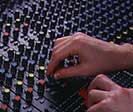| Author
|
Do you use compressors when you're producing
|
Freeflow
IsraTrance Full Member

Started Topics :
60
Posts :
3709
Posted : Apr 24, 2007 02:42
|
Setting the treshold very low, does this mean to compress alot of the sound? its counted in Db the treshold, so a low setting would be like -30Db?
what is high and what is low?
|

|
|
ess765
IsraTrance Junior Member

Started Topics :
25
Posts :
169
Posted : Apr 24, 2007 08:28
|
Threshold determines the level at which the compressor will begin to proportionately reduce(ratio) the incoming signal.
The ratio will tell you the input-to-outup gain slope.
Usually around -5 to -15db could be subtle. Near -20db and lower could really make the compressor sensitive. Obviously the ratio will tell you how much gain reduction will the input signal get whenever the threshold value is reached. A 1:1 ratio will not affect the input signal no matter how ow is the threshold set.
There s no precise numbers for your question.
In very simple terms, compression basicaly is used to reduce the dynamic range of a signal.
Field test:Take a look at the gain reduction meter, while you tweak the threshold and ratio with slow atack and release settings as an experience. Subtle gain reduction on the meter could be considered around -1 to -4db....
        Ess765 (aka Physical Absence) Ess765 (aka Physical Absence)
Visit me at my project s page at:
www.myspace.com/physicalabsence
"when you think you know all the answers, life suddenly changes all the questions" |

|
|
PoM
IsraTrance Full Member

Started Topics :
162
Posts :
8087
Posted : Apr 24, 2007 10:48
|
|
if you set the attack and release with a very low treshold,you ll need to adjust them again with less gain reduction and then move a bit the treshold to see where it sound the best. |

|
|
TuK
TuK

Started Topics :
41
Posts :
228
Posted : Apr 24, 2007 12:09
|
|
i compress 90% of the tracks, i like to compress leads in order to make them more upfront, kick and bass i compress seperatly because i like the control over the attack and the release to make the bass "pumpy", im a little suprised to see that their are people who rairly use them. i also do all of the mixing together while producing, i dont have a seperate mixing stage, it has its advantages and disadvantages but i just failed trying to do it any other way. |

|
|
Spindrift
Spindrift

Started Topics :
33
Posts :
1560
Posted : Apr 24, 2007 15:15
|
I mostly use them on occasions where I have no other way of controlling the dynamics.
With kick and bass I make sure to have sources where i think the envelopes is good from the start.
With synths I try to make sure envelopes and velocity ensure that the sound is having the right dynamics, but sometimes after applying modulation like phasers compression compression comes in handy.
Samples like unprocessed loops, voices and fx will also usually need a bit of compression.
        (``·.¸(``·.¸(``·.¸¸.·`´)¸.·`´)¸.·`´) (``·.¸(``·.¸(``·.¸¸.·`´)¸.·`´)¸.·`´)
« .....www.ResonantEarth.com..... »
(¸.·`´(¸.·`´(¸.·`´``·.¸)``·.¸)``·.¸)
http://www.myspace.com/spindriftsounds
http://www.myspace.com/resonantearth |

|
|
faxinadu
Faxi Nadu / Elmooht

Started Topics :
282
Posts :
3394
Posted : Apr 24, 2007 16:17
|
most of the talk here is about compressors in the technical use ie controlling peaks.... but if you have some nice analog/tube stuff, or a nice digital emulation like the vinco... then a compressor becomes also an artistic tool for warmth and character.
       
The Way Back
https://faxinadu.bandcamp.com/album/the-way-back |

|
|
UnderTow

Started Topics :
9
Posts :
1448
Posted : Apr 24, 2007 16:36
|
This is something I posted a while back.
Quote:
|
So how does compression work?
Any signal with a level above the threshold will be "compressed" downwards in volume according to the ratio settings of the compressor.
Lets say you have the threshold set to -10 dB and a signal comes in at -5 dB. That means that the signal is 5 dB above the threshold. If you have your ratio set to to 2:1 it means that the volume of this signal will come through as 2.5 dB (5 dB / 2) above the threshold making it -7.5 dB. If the ratio is set to 4:1 it will come through as 1.25 dB (5 dB / 4 ) above the threshold or -8.75 dB.
The attack settings determines how fast the compressor reacts to signals above the threshold. So if you set the attack at 10 ms, it will take 10 ms for the compressor to fully compress the incoming signal once it passes the threshold.
The release setting determines how long it takes for the compression to stop having any effect. So if you have your release set to 100 ms, it will take 100 ms for the compressor to stop compressing after the signal has passed below the threshold.
The gain setting just sets how much gain is applied to the signal before it gets sent out of the compressor. Some compressors have auto-gain which automaticly gives more or less as much gain as the signal is being compressed.
The knee characteristic determines how "exact" the threshold setting is. With hard knee, the compressor only starts working when the signal passes the exact threshold value. A soft 6 dB knee means that the compressor will allready start compressing lightly 6 dB below the threshold. It will compress more and more as the signal gets closer to the threshold and compressor fully according to the ratio setting by the time the signal is actually at the exact threshold value.
That should get you started. Now experiment with different attack/release/threshold/ratio settings with different sounds and see what what happens. Thats the best way to learn IMO.
|
|
UnderTow |

|
|
Andrew
Voice Of Cod / Zuloop

Started Topics :
14
Posts :
218
Posted : Apr 24, 2007 17:15
|
Quote:
|
On 2007-04-23 00:08, cytopia wrote:
I use compression on alot of channels, but with different settings depending on what I want to do to the sound. On percussion compression can make it more punchy, and with synth leads and pads etc you can bring out some of the background sound, and make it more audable if you compress it a bit. I try not to overcompress and to set the attack release, ratio and threshold to the right setting for what I want to do, and this takes some practice, but you can hear it better if you set the threshold really low and ratio really high, play the sound, then while its being super processed like this, set the attack, then set the release... you see with the ultra low threshold and very high ratio its compressing hard and you can actually hear very well what the changes in attack and release are doing to the sound.... then when those are set, set the ratio, and then last the threshold to where they ought to be. Alot of people work this way and it does really help 
|
|
yeah this is pretty well the way Mike Stavros suggests to tweak comps in his book "Mixing with your Mind" . I've been practicing this method and it sure does work for the sounds that don't just need a bit of tune, but which need a particular shape of compression |

|
|
Freeflow
IsraTrance Full Member

Started Topics :
60
Posts :
3709
Posted : Apr 24, 2007 23:49
|
ess765 and undertow - thanks 
|

|
|
ImaD

Started Topics :
0
Posts :
2
Posted : Apr 26, 2007 04:17
|
[quote]
On 2007-04-21 22:54, Colin OOOD wrote:
Yes, if the sounds need them 
[/quote] |

|
|
The_Guardians_Of_Truth
Atma

Started Topics :
16
Posts :
379
Posted : Apr 26, 2007 13:59
|
Quote:
|
On 2007-04-22 12:07, shachar wrote:
i compress almost everything before mix..
its also for reasons of taste but it help my mix to be more rock solid
|
|
me also !
but that's not all ! I use also a mastering rack (hardware rack) on the output of my main mixer when i compose the song.
I have some very good mastering settings (compresion, stereo expander, multiband enhancement,eq, limmiter) on this hardware, wich was tested before on many tracks and on many sound system.
So, when i compose a track i already have a aproximate image about how the track will sound after the mastering process. This rack also help me to bring all my tracks on the same quallity and same dynamics and eq, even if i use totally different instruments. And also it helps me to correct problems in the track wich, without it i would not noticed.( maybe only the sound engineer will notice them when it will master my songs,...and sometimes is too late to corect them!)
of course, when the track is finnished the mastering rack will be take off (bypassed), and i leave the finnal mastering to the sound engineer (wich is in most cases..again...me  ) ! ) !
        NEW ALBUM OUT SOON !!! NEW ALBUM OUT SOON !!!
"ATMA - Music Revolution"
www.myspace.com/atmastudio |

|
|